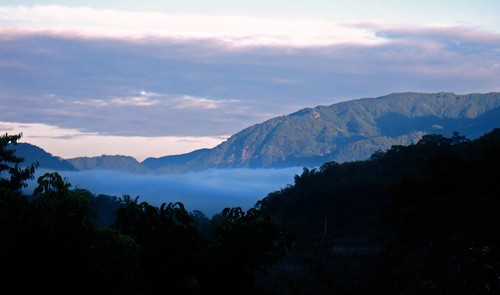
As the clouds of sleep lifted from my head, I flung my eyes open wide and stumbled over my legs as the sensation of feeling returned to my rested limbs. Through the picture frame window I could look off toward the rocky walls of the valley illuminated by the reddish gold hues of morning sunlight.
The skies were crackling clear the way they are on sunny Taiwanese winter days when there is no humidity to hang from your body from the moment you step out of bed. We were going to have as perfect weather as imaginable on our ascent of the unobstructed north face of Alishan.
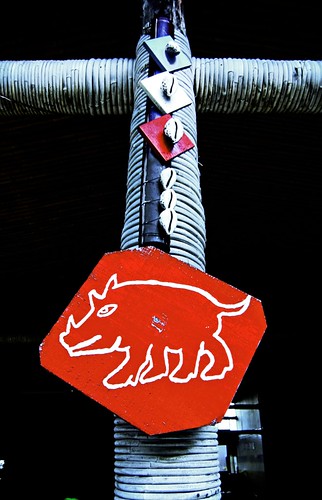
With dry clothes, thanks to the convenient heat from the hearth, we were directed toward the town breakfast shop. They had a full spread of Taiwanese style breakfast sandwiches, egg pancakes, and other breakfast necessities. It is so rare to enjoy such a spectacular spread in the mountains. Even the lettuce in my breakfast sandwich was fresh from the garden. The real treat was when I ordered a coffee and received an espresso bar paper cup of hot black coffee instead of a dixie cup of sweetened powdered brew that makes a regular coffee drinker wince tears of vinegar with every sip. I had a full cup of BLACK Friggin' COFFEE.
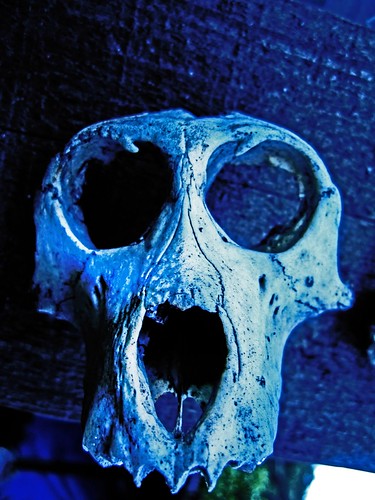
In the crisp morning light the town looked clean and friendly. The locals were all sweeping the streets and wearing traditional Tsou costume for Sunday service at either of the two local churches. The Presbyterian and Catholic churches stand about a block apart. In the realm of Taiwan politics they might as well have been a world apart. The Taiwan Presbyterian Church was an early advocate of social justice during the era of White Terror and martial law in Taiwan, while the Archdiocese has remained close to the ruling Kuomintang since the KMT lost China to the communists. The Vatican still recognizes Taiwan's ROC government as the true government of China. These political and ideological battles are often fought by religious proxy in indigenous villages all over Taiwan.

What was evident was that the church played a central role in village life. Over the centuries many groups of Taiwanese indigenes have sought out foreign missionaries to help them gain political and economic leverage against state power and an unequal distribution of goods, benefits and rights.
In many ways these indigenous communities have subverted the church organizations as a means to serve more traditional functions of indigenous village life. The churches also act as a deliberate means of drawing borders between an ethnic minority and the orthodoxy of the state as the civilizing center; a powerful act of resistance by othering oneself while retaining a sense of ethnic integrity.
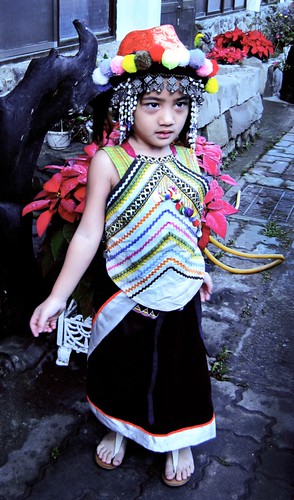
We each ponied up NT900 to cover our rooms, dinner, breakfast and coffee, as well as the beers we shared. It all came on one tab and we were ready to roll back onto the road. My butt was still a little sensitive and my legs gummed up from a tight sleep, but I was game for a charge at Alishan.
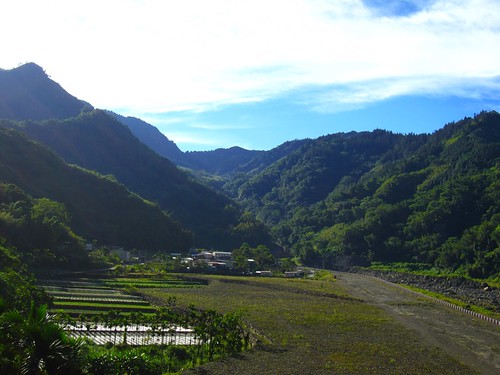
In the daylight the Route 155 took us out of Laiji and past the geological scars left by the devastating blows of Typhoon Morakot, which pummeled Taiwan in 2009. In the wake of massive landslides and flooding, Laiji was labelled a disaster area. The central government proposed moving the community to an area deemed safer and less of a disaster risk. The Tsou of Laiji negotiated a move to an area that was formerly a traditional Tsou village site deeper in the mountains. The government accepted the proposal, but reneged on the promise.
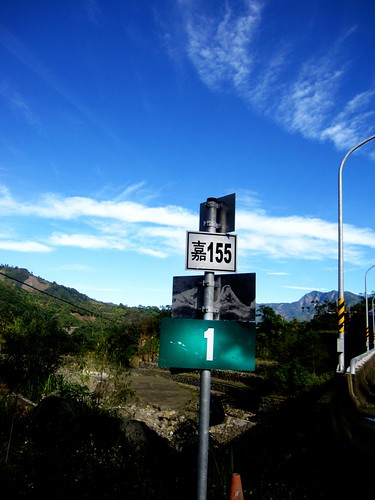
With the morning sun beginning to radiate off the polished rocky cliffs, a light haze filled the air as precipitation in reverse with the saturated earth raining on the heavens.

My legs warmed up as we crossed the bridge up the 149甲. I had the advantage of knowing the route well enough to gauge when, where and how to spend an effort. I quickly rocketed up the lower ramps until I found a comfortable spot in the shade to take pictures of the rest of the group. I designated myself the ride documentarian as I had nothing to prove but a good time on the slopes of Alishan.
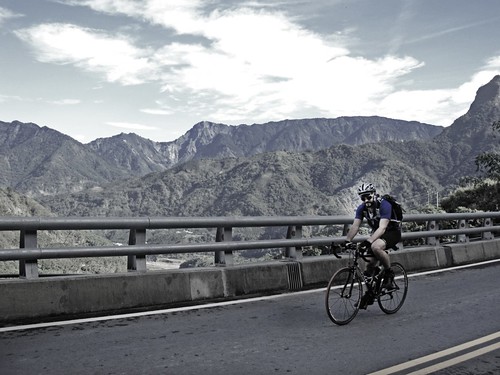
Each rider plodded up the smooth asphalt at his own pace. Dom's training regimen paid off and he quickly disappeared into a buckle along the mountain's flank. I would stop for pictures and then race ahead to search for more choice shots. Each rider had his own plan for the ride and scrapped for elevation in a beautiful game of speed, power and finesse.
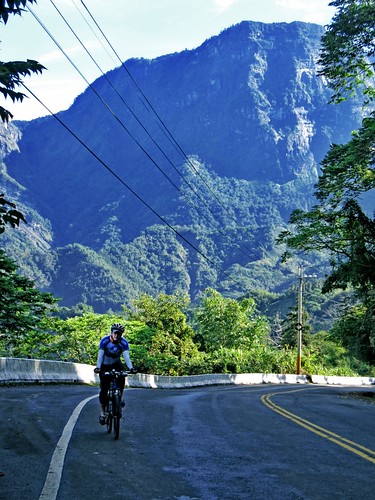
The chunky rocks with their angular faces and deep striations seemed to resemble the bare canyon walls and spires of the American West rather than the forests of a mountain that sits squarely on the Tropic of Cancer.
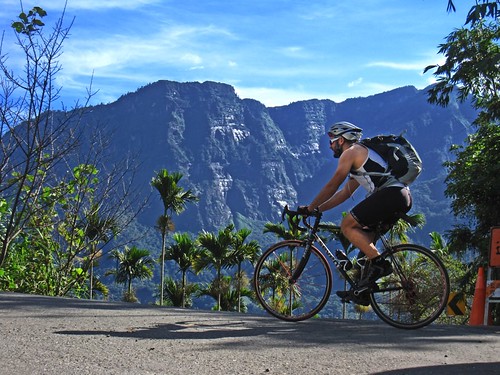
Bend after agonizing bend we lunged skyward leaving the dusty riverbeds and betel nut trees far below. The road is in near pristine condition and on this day there was very little traffic. The quietness of the bicycle brings out the detail and contrast in each image and sound along the road. The bicycle frees up the senses and faculties that would be otherwise employed in the operation of a motor vehicle and delights the rider with a sumptuous panorama of sensory experience.
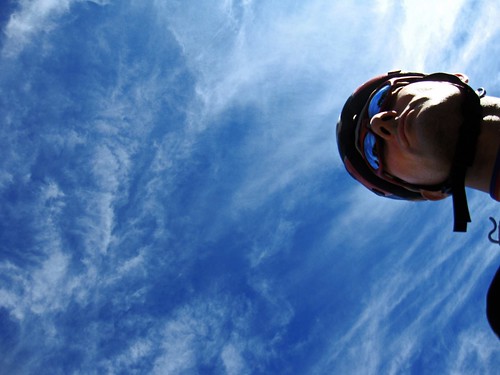
On days like this, when the marble sky swirls around itself, you can't help but look up.
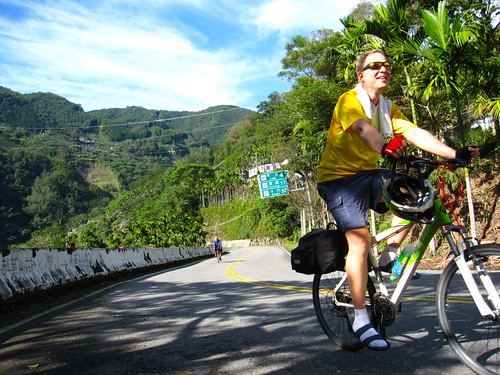
Cranks turned and legs burned.
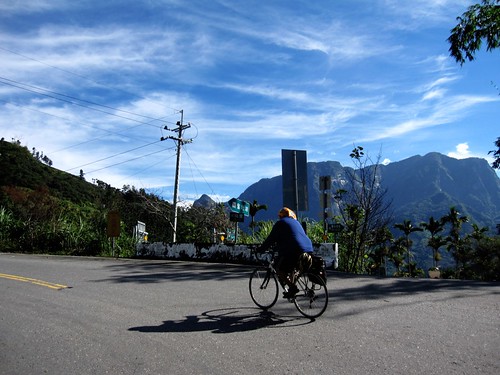
Michael had outfitted his bike with a special long cage derailleur and mountain bike sized sprocket set-up specifically for this climb. The new gear ratios and a higher level of fitness made a made a huge difference as he had plenty of energy to take on each ramp all the way to the top.
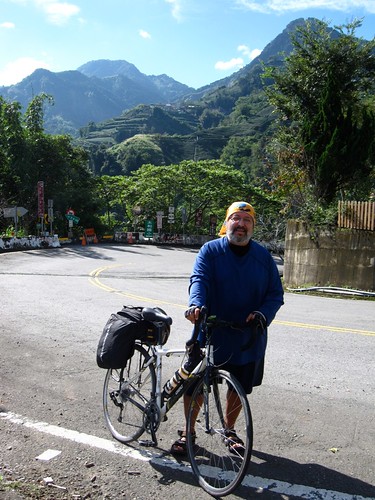
For the most part the route to Fencihu is clean and clear. There are always a couple sections where construction is immanent. This time the concrete slurry and dusty roadway had been replaced by a brand new Route 162 junction of sparkling newness.
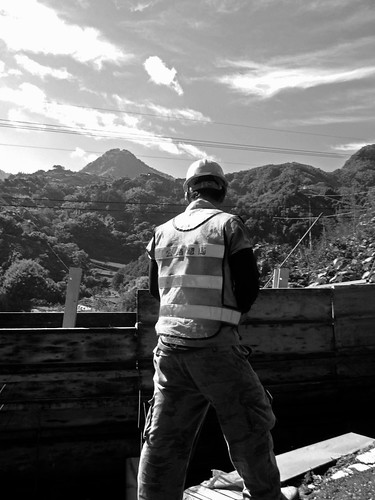
Halfway through the ascent, conversations that could take moments over a beer drag on as heavy breaths and concentration chop and dice sentences into non-sequitur arrangements of sounds and syllables.

Just near the three-quarter mark of the climb the entire valley starts coming into view from the mosaic of peeks and views available on the lower sections. We could look out at our road dangling on the edge of nothing; a bright white scribble against the deep greens of tea and bamboos.
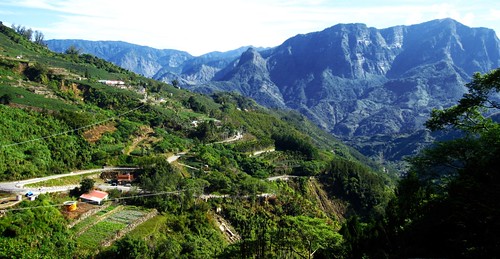

As I stopped to record the visuals of our riders filing along the naked cliffside against a jagged-scape of rock against blue, I noticed the shape of a cyclist on a road bike pushing his way up the cliff behind us.
At first I thought it might be one of the riders who had failed to materialize Saturday morning and in a fit of remorse decided to give chase in a one-day tour de force of Alishan cycling. The notion came from the fact that road is not yet a favorite among cyclists due to it being a full campaign over two mountains. Once you commit to the descent of the first, you automatically sign up for the ascent of the next. There is really no clean way out if things go poorly. Any rider on these roads is serious about making it to the other side.
The notion of a friend coming to join us was short lived as we waited to discover a lone Taiwanese rider mashing along the same road. I managed to chase him down and chat for a few minutes as we made slow headway into the tea farming village of Taiho.
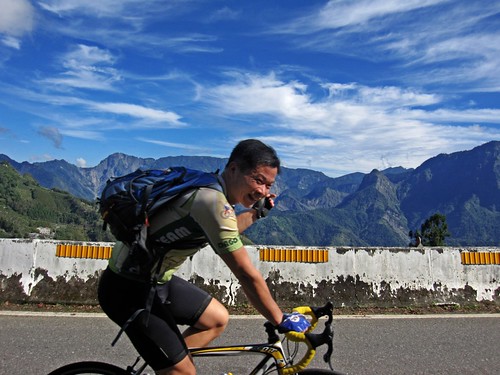
At the three quarter mark we stopped for a photo-op.
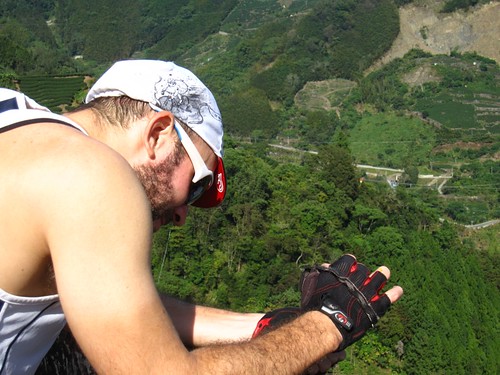

Taiho is a patchwork labyrinthine maze of tea fields, one folded atop the next to cover the highest slopes. The tea is harvested from impossibly steep ledges as the local farmers have sought to claim every inch of arable land for tea production.
Even where sections of mountain have sloughed off in earthquakes and storms, the famers have simply planted around boulders and obstacles.
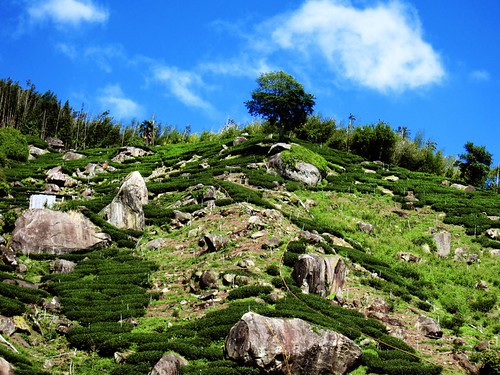
The rest at Taiho was short to keep our forward momentum.
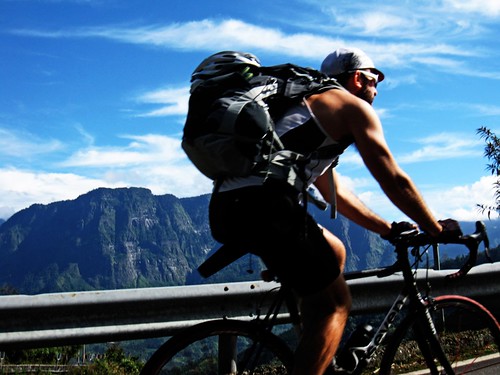
Dom quickly launched back up the mountain and didn't materialize until Fencihu while the rest of the crowd soaked in the splendors of surreal landscapes below.
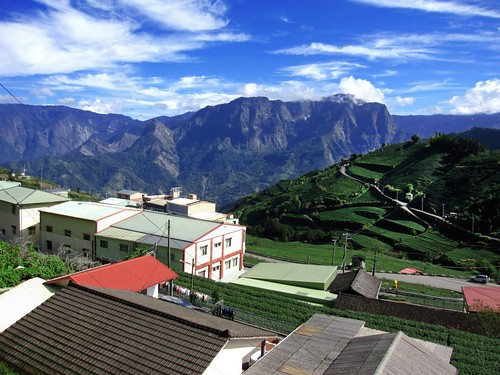
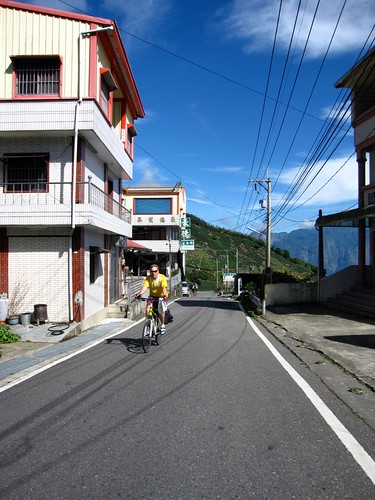
Just after Taiho there is a brief section of steep roadway that mows weaving arcs through a bamboo forest as a transition between the verdant, emerald slopes of Taiho and the dark cedar in Fencihu.
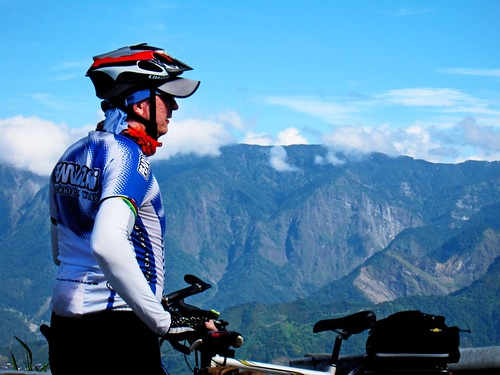
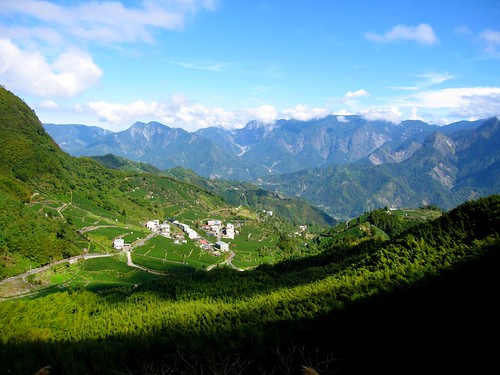
As I rounded one of the last corners to the final terrace above Taiho, I passed our Taiwanese friend whose legs had failed him somewhere below. I spun in my seat in time to watch him valiantly remount and plod the final paces to meet a group of friends from his DAGO cycling group as they took the more leisurely route from Fencihu.
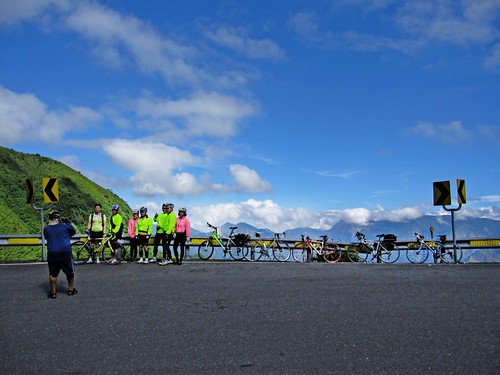
With very little gladhanding or celebration in summiting on this route, I mechanically marched ahead for a revitalizing coffee in Fencihu.
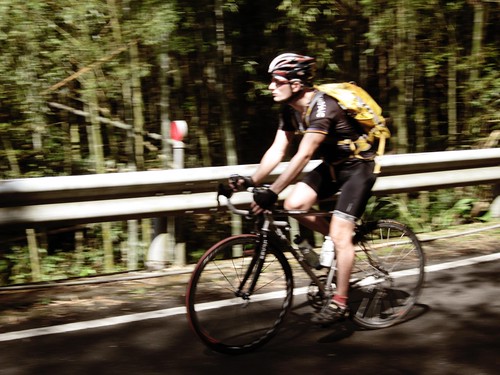
The race down the other side seems a world away. The cool darkness and flickers from blinding spots of warm sunlight between the boughs of tall cedars provides the sensation of cycling through a moving picture. This was one of the nicest days I have ever seen on Alishan, which is often muffled by clouds and haze.
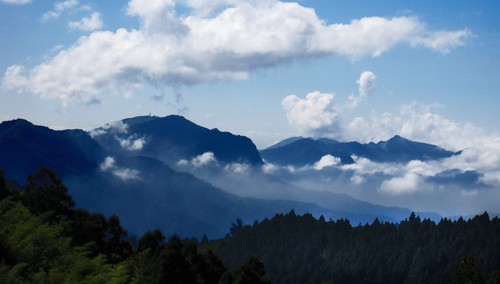
We all sat back for refreshments at a little cafe in Fencihu and made light of our adventure. There were fewer tourists and less traffic on the roads. This made the front of Alishan more pleasant than I remembered.
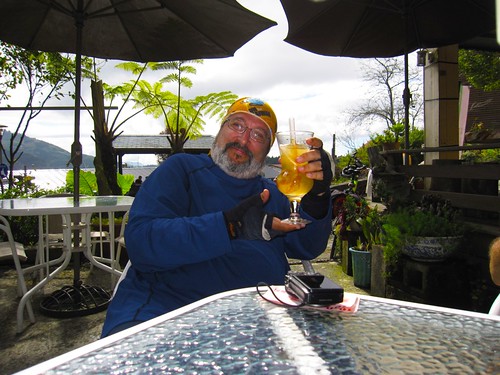
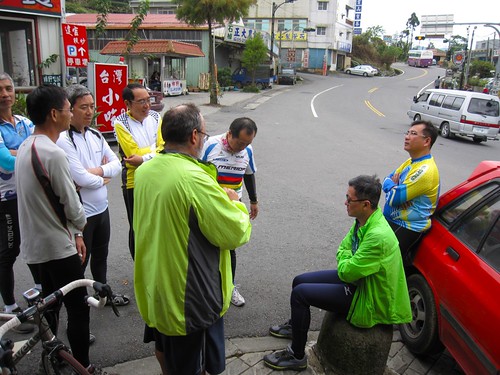
Michael holding court
When I think of this ride I always imagine it consisting of three distinct parts.
The first is the warm up over the foggy grey rocks and decay of the climb through Caoling. The second is the climb through the exposed northeastern flank of Alishan through Taiho.
The third section is just as impressive and distinct in character as the other two parts, and I think it is the key element in making this route among the greatest rides in Taiwan.
As cyclists we often get caught up in the numbers game and measure our ride in terms of altitude, distance, speed, gear ratios, gradient percentages and other hard data.
In the sport of competitive cycling an effort can also be measured by the subjectivities wrapped in the single French term-- panache.
Panache defines the style and manner in which a ride is executed.
For Alishan, there are other routes that reach higher points on the mountain or pass more famous scenic spots on the tourist map. The Highway 21 through Tata Jia and Highway 18 are the standard roads for riding Alishan. These are fine, but they lack the panache of the route outlined in this post. They lack the two climbs, the cliffside scenery, the bare loneliness of the rider dwarfed by the enormous mountain shadows that loom from above. Moreover, they lack the descent down the 159甲.
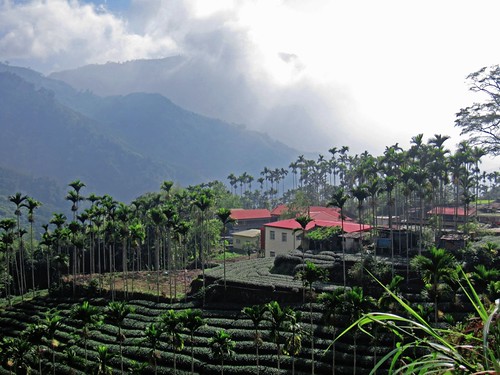
The 159甲 starts off easy enough and the thrill snowballs through every corner and dip as the skinny track hugs the precipice along an old Tsou trading road.
"Now it is time to enjoy the refinement of a custom ride." I called to Dom as we gained momentum.
You can clearly see where you're going as you skip and flow like leaves in the trickling steams below. But there are surprises around every root and rise of the mountain.
There is dipping and slicing around every corner as you jump from the saddle to take full advantage of your inertia, which creates a zen-like sensation of effortless concentration and reaction. You enter "the zone" and stay for the entire ride.
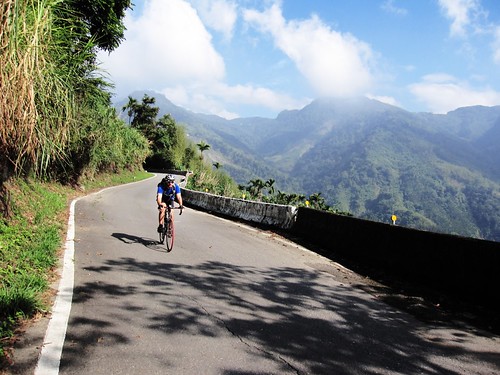
Sheer cliff faces stare back at you and require a moment of awesome reflection.

It seems each tuck and bend reveals hidden tea farms, majestic waterfalls, and fearsome ledges.
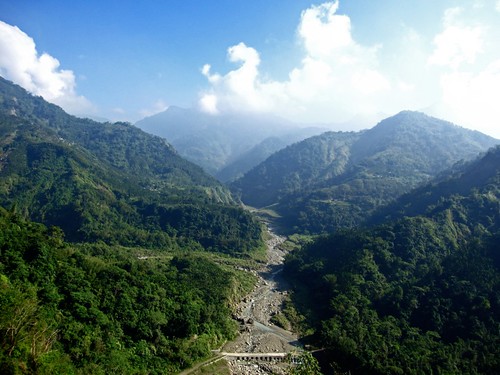
The road contorts and burrows through jungle and along the fingers of deep gullies with their iron-work bridges. At times it seems as thought the entire road might simply close in on you like the Wandering Rocks of the Odyssey.
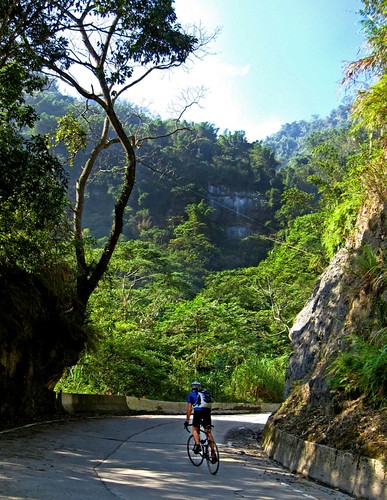
Then, just as the legs shift into recovery mode, there is one last climb that is anything but gentle.
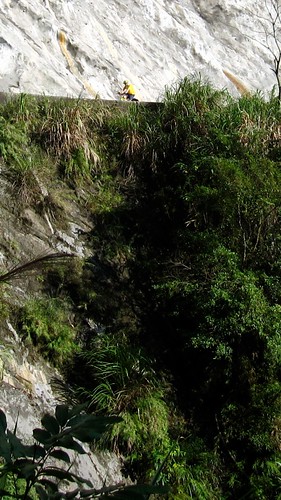
The road pitches up for a steep sustained climb through two tunnels. It evens out only briefly before another staggering climb before sliding into the most surreal betel nut forrest. The chalky grey and white trunks of betel palms soot up from all sides with large boulders all around. There is something spooky about it that words fail to describe.

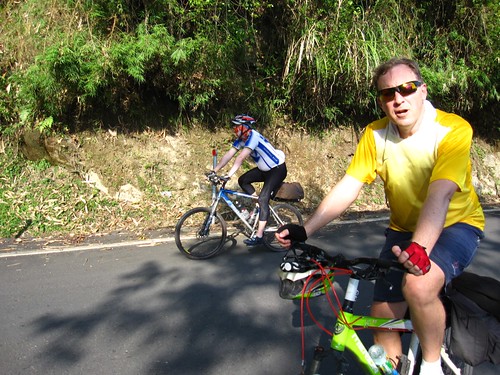
The bottom falls off the 159甲 as it points its nose down one last time and cuts wide banking corners in a slalom through persimmon farms toward the Chiayi City.
Dom and I continued onward to the HSR station, which is poorly marked from Chiayi City and took far too much mental energy to locate. Without WiFi, if we had followed the signage, we would have ended up in Tainan.
A completely amazing trip and an excellent birthday present to myself.
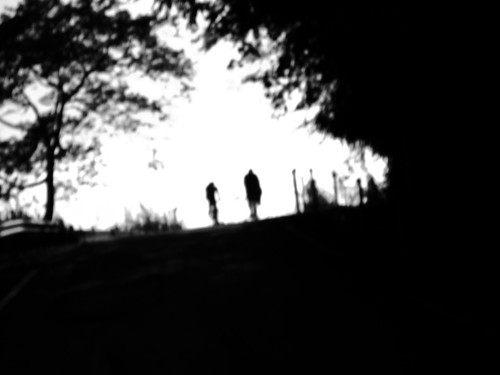
When I pulled up at the HSR station I was met with that little girl smile that makes it so hard to leave and so great to return from a long ride.

A little volcano action at Chili's made it all that much better.
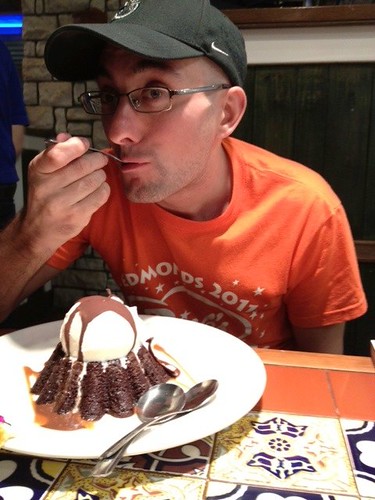
Michael Turton's Excellent Post on the Trip. Here
Information:
Lan Hou Hostel (Laiji)
Address: Alishan Township, Laiji Dist. Chiayi County, Laiji Village No.11
Tel: 05-266-1002/05-266-1172
Cell: 0978-208137

Fantastic post Andrew - look forward to doing it myself at some point - great pictures too - just got to wait for my leg to get better.
ReplyDeleteyeah cracking piece!
ReplyDeleteLooks like a fantastic trip.
ReplyDeleteI went for the first time to Alishan this year with the family, 13 of us - not by bike as only two of us could drive and I was one of them :o)
We drove up the 159 and made a detour on the way down at Fenchihu. My brother-in-law and I talked about riding up and how long it would take. 159 seems to be the main route for cars and made buses. I guessing that this time of year the roads in general around Alishan are a little less busy, fair to say?
May be next time we'll ride it.
The main road is the Highway 18. The 159甲 is too skinny for busses and too inconvenient. It is a nicer road than the Highway 18 and much less traffic. The tour busses all take the Highway 18... and tend to crash there as well. If you are in reasonable shape is should take a couple of hours to climb up.
ReplyDelete